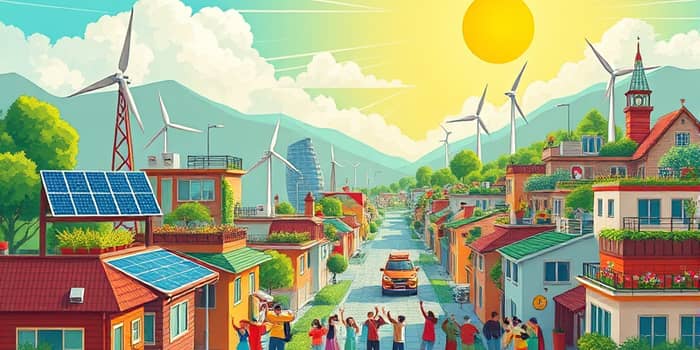Access to capital often determines whether a sustainable vision becomes reality. By choosing empower your sustainable journey, eco-friendly loans allow individuals and businesses to transform green ideas into tangible projects.
These specialized financing options combine financial innovation with environmental stewardship, unlocking opportunities that benefit both borrowers and the planet.
Understanding Green Loans
Green loans are tailored, activity-based loans whose proceeds fund initiatives with clear environmental benefits. Unlike traditional financing, they ensure that every dollar supports sustainability, from renewable energy installations to water conservation systems.
They mirror green bonds in purpose but operate in the private lending market, offering flexibility for both individuals and corporations seeking to reduce their carbon footprint.
- exclusive allocation of loan proceeds: Funds must be allocated exclusively to eligible green projects.
- clear project evaluation and selection criteria: Projects undergo a rigorous environmental assessment.
- transparent tracking of allocated funds: Lenders and borrowers commit to detailed record keeping.
- regular environmental impact reporting: Borrowers provide updates on project benefits.
Popular Categories of Eco-Friendly Loans
Green loan products span a wide range of applications, making sustainable financing accessible for residential, automotive, and commercial purposes.
- Residential Green Loans: Solar panel installation, energy-efficient home improvements, greywater systems, and high-efficiency heat pumps.
- Green Automotive Loans: Electric and hybrid vehicle purchases, low-emission cars, and charging infrastructure.
- Commercial Green Loans: Renewable energy projects, energy-efficient building upgrades, and sustainable equipment investment.
Financial Benefits of Green Loans
Eco-friendly loans not only drive environmental progress but also deliver compelling financial advantages that can enhance long-term stability.
Many eco-loans feature low-interest rates with flexible terms, including options like no upfront payments, fixed rates, and no prepayment penalties. These terms align incentives, making sustainable projects financially feasible and attractive.
Sustainable Finance Market Trends
The global sustainable finance market is poised for exponential growth, with projected bond issuance reaching $1 trillion in 2025. This surge reflects heightened demand for capital that aligns with environmental, social, and governance (ESG) criteria.
Key growth drivers include government incentives, evolving regulatory frameworks, and corporate commitments to net-zero targets. However, challenges such as heightened scrutiny of greenwashing and inconsistent standards could temper momentum, requiring robust verification and transparency.
Interest in climate adaptation and nature-focused financing continues to rise, steering investments toward diverse projects from wetland restoration to resilient infrastructure.
Leading Green Loan Providers
Several institutions have distinguished themselves through specialized products and favorable lending conditions.
- long-term solar financing with fixed rates: Clean Energy Credit Union offers customized loans with repayment periods up to 20 years for solar electric systems.
- versatile green loans for homes and businesses: Vermont Credit Union finances e-bikes, high-efficiency heat pumps, energy-efficient appliances, and electric vehicles.
- Traditional Banks and Lenders: Many conventional banks now provide diverse green loan options, often with varying eligibility criteria and terms.
Navigating Challenges and Making Impact
While green loans unlock powerful opportunities, borrowers and lenders must navigate several obstacles to ensure genuine impact.
Standardization issues mean definitions of “green” can vary widely between institutions. Moreover, project proponents must guard against greenwashing by insisting on rigorous environmental benchmarks and third-party validation.
Supply chain risks and implementation gaps also pose hurdles. Borrowers should conduct comprehensive risk assessments, engage local stakeholders, and adopt best practices in supplier management to mitigate these concerns.
Steps to Secure Your Eco-Friendly Loan
Begin by clearly defining your project scope and environmental objectives. Detail energy savings, carbon reductions, or resource efficiencies to demonstrate impact.
Next, research multiple lenders, comparing interest rates, repayment terms, and reporting requirements. Choosing a lender committed to sustainable finance can enhance support throughout your project lifecycle.
Prepare a comprehensive business case, including technical specifications, cost estimates, and projected environmental benefits. Transparency and accuracy build credibility with lenders and stakeholders.
Finally, negotiate clear reporting schedules and metrics. Establishing transparent communication channels ensures ongoing accountability and fosters trust.
Conclusion
Eco-friendly loans represent a transformative tool in the journey toward a sustainable future. By blending financial innovation with environmental purpose, they empower projects that yield both economic returns and ecological gains.
As you explore financing options, remember that each investment shapes a global movement toward resilience, equity, and shared prosperity. Commit to positive environmental legacy and watch your sustainable aspirations flourish.
References
- https://www.worldbank.org/en/news/feature/2021/10/04/what-you-need-to-know-about-green-loans
- https://online.hbs.edu/blog/post/types-of-sustainable-debt
- https://www.aspiration.com/resources/what-is-a-green-loan
- https://www.nordea.com/en/news/what-are-green-loans
- https://www.wfw.com/articles/green-and-sustainable-loans-a-short-explainer/
- https://www.moodys.com/web/en/us/insights/credit-risk/outlooks/esg-sustainable-finance-2025.html
- https://www.rba.gov.au/publications/bulletin/2023/sep/green-and-sustainable-finance-in-australia.html
- https://www.fibe.in/blogs/what-is-green-finance/










